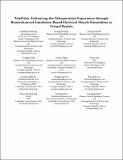| dc.contributor.author | Hwang, Seokhyun | |
| dc.contributor.author | Kang, Seongjun | |
| dc.contributor.author | Oh, Jeongseok | |
| dc.contributor.author | Park, Jeongju | |
| dc.contributor.author | Shin, Semoo | |
| dc.contributor.author | Luo, Yiyue | |
| dc.contributor.author | DelPreto, Joseph | |
| dc.contributor.author | Lee, Sangbeom | |
| dc.contributor.author | Lee, Kyoobin | |
| dc.contributor.author | Matusik, Wojciech | |
| dc.contributor.author | Rus, Daniela | |
| dc.contributor.author | Kim, SeungJun | |
| dc.date.accessioned | 2025-09-30T16:39:24Z | |
| dc.date.available | 2025-09-30T16:39:24Z | |
| dc.date.issued | 2025-04-25 | |
| dc.identifier.isbn | 979-8-4007-1394-1 | |
| dc.identifier.uri | https://hdl.handle.net/1721.1/162840 | |
| dc.description | CHI ’25, Yokohama, Japan | en_US |
| dc.description.abstract | This paper introduces TelePulse, a system integrating biomechanical simulation with electrical muscle stimulation (EMS) to provide precise haptic feedback for robot teleoperation tasks in virtual reality (VR). TelePulse has two components: a physical simulation part that calculates joint torques based on real-time force data from remote manipulators, and an electrical stimulation part that converts these torques into muscle stimulation. Two experiments were conducted to evaluate the system. The first experiment assessed the accuracy of EMS generated through biomechanical simulations by comparing it with electromyography (EMG) data during force-directed tasks, while the second experiment evaluated the impact of TelePulse on teleoperation performance during sanding and drilling tasks. The results suggest that TelePulse provided more accurate stimulation across all arm muscles, thereby enhancing task performance and user experience in the teleoperation environment. In this paper, we discuss the effect of TelePulse on teleoperation, its limitations, and areas for future improvement. | en_US |
| dc.publisher | ACM|CHI Conference on Human Factors in Computing Systems | en_US |
| dc.relation.isversionof | https://doi.org/10.1145/3706598.3713767 | en_US |
| dc.rights | Creative Commons Attribution-Noncommercial-ShareAlike | en_US |
| dc.rights.uri | http://creativecommons.org/licenses/by-nc-sa/4.0/ | en_US |
| dc.source | Association for Computing Machinery | en_US |
| dc.title | TelePulse: Enhancing the Teleoperation Experience through Biomechanical Simulation-Based Electrical Muscle Stimulation in Virtual Reality | en_US |
| dc.type | Article | en_US |
| dc.identifier.citation | Seokhyun Hwang, Seongjun Kang, Jeongseok Oh, Jeongju Park, Semoo Shin, Yiyue Luo, Joseph DelPreto, Sangbeom Lee, Kyoobin Lee, Wojciech Matusik, Daniela Rus, and SeungJun Kim. 2025. TelePulse: Enhancing the Teleoperation Experience through Biomechanical Simulation-Based Electrical Muscle Stimulation in Virtual Reality. In Proceedings of the 2025 CHI Conference on Human Factors in Computing Systems (CHI '25). Association for Computing Machinery, New York, NY, USA, Article 365, 1–26. | en_US |
| dc.contributor.department | Massachusetts Institute of Technology. Computer Science and Artificial Intelligence Laboratory | en_US |
| dc.identifier.mitlicense | PUBLISHER_POLICY | |
| dc.eprint.version | Final published version | en_US |
| dc.type.uri | http://purl.org/eprint/type/ConferencePaper | en_US |
| eprint.status | http://purl.org/eprint/status/NonPeerReviewed | en_US |
| dc.date.updated | 2025-08-01T08:11:37Z | |
| dc.language.rfc3066 | en | |
| dc.rights.holder | The author(s) | |
| dspace.date.submission | 2025-08-01T08:11:38Z | |
| mit.license | PUBLISHER_CC | |
| mit.metadata.status | Authority Work and Publication Information Needed | en_US |
